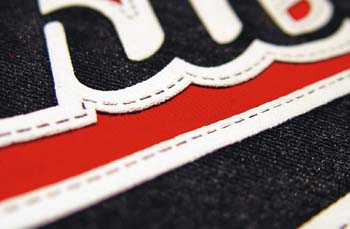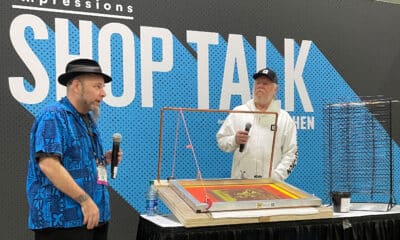Garment Printing
Published
11 years agoon

One of the most critical steps in the screen-printing process is drying, or curing, of ink after it has been applied to the screen-printed product. This is accomplished by heating the ink to the temperature at which it cures, as a printed garment or other item passes through a dryer on a conveyor belt. Popular plastisol inks require cure temperatures of approximately 320-340°F, while other types of ink cure or bond at slightly different temperatures.
One of the most critical steps in the screen-printing process is drying, or curing, of ink after it has been applied to the screen-printed product. This is accomplished by heating the ink to the temperature at which it cures, as a printed garment or other item passes through a dryer on a conveyor belt. Popular plastisol inks require cure temperatures of approximately 320-340°F, while other types of ink cure or bond at slightly different temperatures.
Choosing between gas and electric
Gas and electric dryers offer different advantages depending on budget, required capacity, available floor space, and the cost of gas and electricity.
Gas dryers have an open flame that heats air within a chamber and transfers the heated air to the area through which garments or other printed items are conveyed. The heat is then transferred to the ink by air convection, equivalent to heating food slowly in a gas oven.
An electric dryer, by contrast, uses infrared (IR) radiation that causes ink molecules to vibrate, generating heat that raises the temperature of the ink rapidly without heating the air around it, akin to heating food in a microwave.
The primary advantage of a gas dryer is its ability to maintain a constant temperature and avoid overheating of the ink. Some disadvantages are dwell times of two to three minutes to heat the ink, requiring long dryer lengths that increase capital cost and consume floor space. Additionally, thick insulation is needed to prevent the outer walls from reaching dangerous temperatures. As a result, gas dryers are generally recommended for large print shops, providing that natural gas or propane is available and less expensive than electric is locally.
Gas dryers are typically larger and more expensive than IR conveyor dryers for several reasons. Gas dryers handle significant volumes of high-temperature air, requiring costly air-handling systems with motors positioned away from the hot air stream. And finally, complex safety controls are required to protect operators from combustible, pressurized gas.
Gas dryers often feature more complicated designs than IR dryers, but they are capable of processing a wide range of printed inks, including discharge inks, water-based inks, plastisols, and specialty formulations. In addition, hot-air recirculation aids in thermal stability and enables hot-air dryers to cure a variety of ink types without risk of scorching.
By comparison, IR conveyor dryers are smaller and often less expensive because they do not require insulation, and they can be shorter in length because IR radiation reaches ink-curing temperatures more rapidly and efficiently than heated air, particularly when curing plastisol inks. However, if items are conveyed through an IR dryer too slowly, the ink can overheat and break down chemically.
A relatively large IR dryer can cure approximately 1000 screen-printed items/hr and can cure thousands more per hour by adding one or more heating chambers, in addition to lengthening the conveyor and increasing its belt speed.
In terms of size, an infrared electric dryer that measures 7-8 ft in length (Figure 1) can cure approximately 300 items/hr, compared to 10-12 ft for a gas dryer of equivalent capacity.
Removing moisture
A common misconception is that forced hot air is needed to evaporate moisture from water-based inks and to expel it from the dryer. In reality, it is infrared radiation that heats the ink and causes evaporation, which is then removed from the heating chamber by a high-velocity exhaust system with high efficiency—on par with the efficiency of an IR dryer curing plastisol inks.
For example, an IR conveyor-dryer that exhausts 400 cu ft/min of air from the drying chamber and supplies roughly 500 cfm of air warms, but does not superheat, the air to pull moisture from the ink and exhaust it, and it prevents outside air from entering through the dryer exit.
Compare quartz to IR panels
If your application calls for an IR electric dryer, you can maximize results by understanding different ways in which infrared radiation is generated.
Some dryers use quartz tubes, while others use infrared panels. Because quartz tubes radiate 360°, they require a reflector to direct energy radiated from the top portion of the tube, back toward the garment. Infrared panels are made of a ceramic quartz fabric and are flat, directing virtually all energy toward the garment, offering higher efficiency (less power usage) per unit of radiation.
Quartz tubes are also relatively fragile and typically have a shorter life, whereas infrared panels often are more durable and have a useful life of up to 20 years, making them less costly in the long run.
Infrared radiation is measured in terms of wavelength (not temperature), which is expressed in microns (μm). For most screen-printing inks, the optimum frequency is 3.2 μm, which is at the top end of the mid-micron range. At this frequency, the infrared radiation is readily absorbed by the ink, causing its molecules to vibrate and generate heat. However, most quartz tubes in dryers for screen-printed items generate infrared radiation in the mid-micron range, which can make them less efficient for curing of screen-printing inks.
Cold spots
An infrared panel is powered by a long, electric wire routed back and forth in a parallel pattern across the panel, with the distance between the wires determining its core density. Because the temperature between wires spaced widely (2 in.) can drop by approximately 100°F, you should specify a heater having wires spaced at approximately 0.75 in., to provide sufficient core density to prevent the ink from cooling as it passes between wires.
Dryer width
It is advisable to specify a wide dryer if budget permits so that you can dry large garments or two small garments side-by-side, as well as blankets, signage, binders, metal parts, advertising specialties, and other screen-printed items. A dryer with a 30-in.-wide belt, for example, cannot cure an overall-printed shirt that measures 40 in. sleeve-to-sleeve.
If your budget is limited, the higher cost of a wider dryer can be offset by purchasing a shorter (less costly) dryer initially and then adding heating chambers, if possible, at a future date to increase capacity as you grow.
Applications beyond garments
It is typically less expensive to purchase a dryer that offers greater capabilities than you need today, than it is to purchase a larger dryer when you require greater capacity or the flexibility to expand beyond garment printing.
Consider that the same screen-printing presses and dryers used daily by thousands of garment printers worldwide are also used to print and dry a range of signage and hard goods.
One example is screen printing on medical-delivery trays (Figure 2) that contain and identify surgical instruments. Because the trays are used several times per day, they are sterilized in autoclaves where they are subjected to pressurized steam after each use, placing rigorous demands on the screen-printed graphics.
Screen printing has long been the industry standard for printing on instrument-delivery systems because of the need to use highly specialized inks that stand up to repeated autoclaving and due to the varying shapes of the trays. This application requires uncompromising quality standards, while others involve irregularly shaped items, extra large (heavy) screens, extremely short runs that have fast setup and microregistration, extremely tight multicolor registration, and other future requirements that may hinge on the capabilities of your screen-printing equipment. It is therefore prudent to select equipment that will expand, rather than limit, opportunities that may arise during your screen-printing career, even if you cannot use some of the equipment’s capabilities at the onset.
Mark Vasilantone is president of Vastex International, Inc., Allentown, PA. All photos courtesy of Vastex International, Inc.

Subscribe

Magazine
Get the most important news
and business ideas from Screenprinting Magazine.
Most Popular
-

 Columns1 month ago
Columns1 month ago8 Marketing Mistakes Not to Make When Promoting Your Screen Printing Services Online
-

 Editor's Note4 weeks ago
Editor's Note4 weeks agoLivin’ the High Life
-

 Press Releases1 month ago
Press Releases1 month agoSports Inspired Clothing Market: The Influence of Sports on Fashion Forward Looks
-

 Marshall Atkinson4 weeks ago
Marshall Atkinson4 weeks agoHow to Create a Winning Culture in Your Screen-Printing Business
-

 Press Releases4 weeks ago
Press Releases4 weeks agoHope Harbor to Receive Donation from BlueCotton’s 2024 Mary Ruth King Award Recipient
-

 Case Studies1 month ago
Case Studies1 month agoScreen Printing for Texture and Depth
-

 News & Trends2 months ago
News & Trends2 months agoWhat Are ZALPHAS and How Can You Serve Them in Your Print Business?
-

 Headlines1 month ago
Headlines1 month agoLive Poster Printing Raises $30K for Charity






